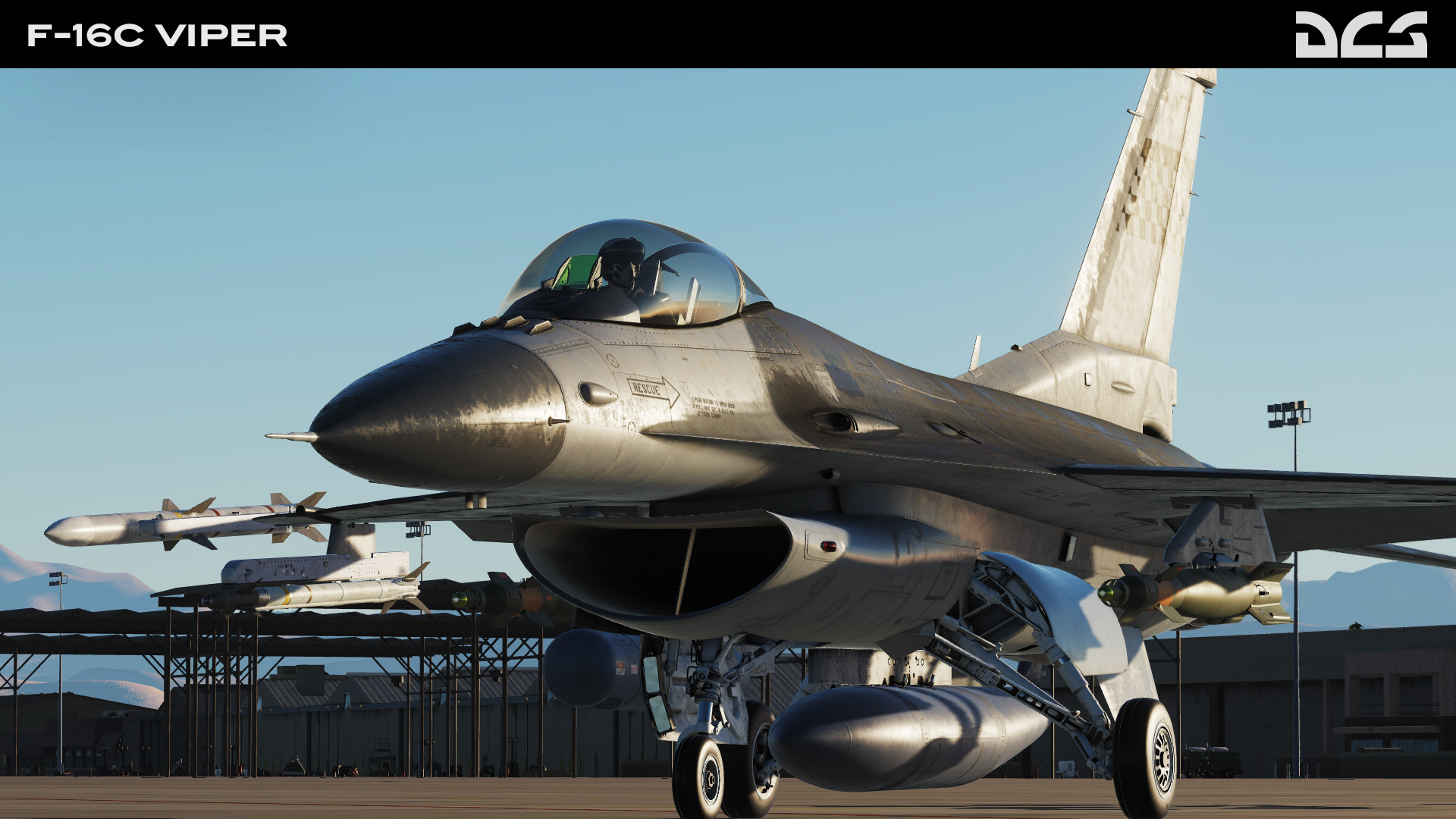
- DCS WORLD F 16 UPDATE
- DCS WORLD F 16 MANUAL
The control stick mainly focuses on using force sensing for feedback, not to be confused for force feedback. The control stick controls the stabilators, ailerons, and rudder and the rudder pedals control the rudder.
Trailing Edge Flaps: Normal flaps located on the trailing (back) edge of the wings to add lift. Leading Edge Flaps: Normal slats located on the leading (front) edge of the wings to add lift. Rudder: A single vertical rudder to control yaw. Ailerons: Two normal ailerons located on the outer area of the wings to control roll of the aircraft. Stabilators: Two "stabilators" (stabilizer + elevator) located at the tail move on a single axis independently of one another to control both pitch and roll of the aircraft. The FLCS also moves surfaces as a function of the angle of attack to provide the best control. This computerized system is called the Flight Control System (FLCS, pronounces "flickus"). It has a "fly-by-wire" (FBW) system, which, opposed to a traditional mechanical or "direct" control system, the inputs given by the cockpit controls are inputted to a computer which then decides what controls to move in order to accomplish the desired maneuver. The F-16C has multiple flight control surfaces for maneuvering the aircraft. Cursor Control / Enable - This allows for the current Sensor of Interest to be manipulated, such as the FCR Acquisition Cursor or pointing the TGP camera. Aft this temporary position extends the airbrake as long as the switch is held in place, keeping it there after release. Forward this position locks in place and retracts the airbrake. Antenna Elevation: This dial wheel (with center detent) controls the radar antenna elevation, allowing the pilot to slew the radar up or down to adjust the radar focus accordingly. DCS WORLD F 16 MANUAL
Manual Range / Uncage Switch: this switch controls the range for air-to-air guns, uncages the missiles, or zooms the TGP depending on the selected SOI and master mode. Right (In): Transmits the current air-to-ground target over datalink. DCS WORLD F 16 UPDATE
Left (Out) : Commands a datalink update.
 Left (Out) : Toggles on and off datalink symbology on the MPDs. Aft (UHF): keys up the UHF radio on the selected frequency for communication to air assets, such as flight members, AWACS or refueling aircraft. Forward (VHF): keys up the VHF radio on the selected frequency for talking to JTAC, ATC, and other land/sea based assets. Instead the throttle pivots on its mounted location to the panel. The throttle for the F-16 is mounted on the left side, thought it is not rail-mounted to the side of the fuselage as its appearance would suggest. FCR SOI: Steps bugged track in TWS or commands HUD scan in ACM. FCR SOI: Commands SAM in RWS mode or commands BORE scan in ACM. HUD SOI: When an A/G bomb is selected, designates SPI in DTOS/EO. Target Management Switch (TMS): The Target Management Switch (TMS) manipulates various sensors depending on what is the Sensor of Interest. Right: Cycles three configured quick access pages on the right MPD from left to right. Left: Cycles three configured quick access pages on the left MPD from right to left. Aft: Sensor of Interest assigned and cycles between the left and right MPDs. Forward: Sensor of Interest assigned to HUD/HMCS. Display Management Switch (DMS): The Display Management Switch (DMS) is used for avionics display manipulation and to assign the Sensor of Interest. Trim Switch: The Trim Switch commands pitch (up/down) and roll (left/right) trim to the FLCS. The stick is mostly stationary and uses pressure sensitivity to be manipulated it does, however, move a small physical distance to give tactile movement response to the pilot.
Left (Out) : Toggles on and off datalink symbology on the MPDs. Aft (UHF): keys up the UHF radio on the selected frequency for communication to air assets, such as flight members, AWACS or refueling aircraft. Forward (VHF): keys up the VHF radio on the selected frequency for talking to JTAC, ATC, and other land/sea based assets. Instead the throttle pivots on its mounted location to the panel. The throttle for the F-16 is mounted on the left side, thought it is not rail-mounted to the side of the fuselage as its appearance would suggest. FCR SOI: Steps bugged track in TWS or commands HUD scan in ACM. FCR SOI: Commands SAM in RWS mode or commands BORE scan in ACM. HUD SOI: When an A/G bomb is selected, designates SPI in DTOS/EO. Target Management Switch (TMS): The Target Management Switch (TMS) manipulates various sensors depending on what is the Sensor of Interest. Right: Cycles three configured quick access pages on the right MPD from left to right. Left: Cycles three configured quick access pages on the left MPD from right to left. Aft: Sensor of Interest assigned and cycles between the left and right MPDs. Forward: Sensor of Interest assigned to HUD/HMCS. Display Management Switch (DMS): The Display Management Switch (DMS) is used for avionics display manipulation and to assign the Sensor of Interest. Trim Switch: The Trim Switch commands pitch (up/down) and roll (left/right) trim to the FLCS. The stick is mostly stationary and uses pressure sensitivity to be manipulated it does, however, move a small physical distance to give tactile movement response to the pilot. 
The control stick is a side-mounted stick used to manipulate the Flight Control System (FLCS), but also has numerous other HOTAS controls. This section will provide a summarized description of all HOTAS controls - detailed functionality will be described in other appropriate sections. The Fighting Falcon's hands on throttle and stick (HOTAS) system is designed to allow the pilot to manipulate important avionics functions without releasing the hands from the throttle or control stick. Weapons not yet implemented into the Viper: Partially or fully implemented weapons of the F-16C Viper: 5.3.1.1 Situational Awareness Mode (SAM).






 0 kommentar(er)
0 kommentar(er)
